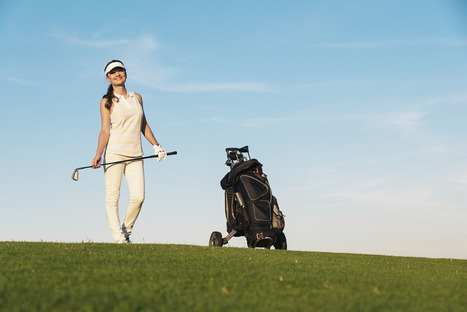The most common causes of golf injuries are playing and practicing too excessively, improper swinging mechanics, and little or no physical conditioning. Pain meds either over-the-counter or prescribed, bracing, and surgical procedures are how symptoms are treated instead of the root cause/s. If the cause/s are addressed then injury prevention comes naturally.
Overuse
Driving requires a great deal of effort and power that puts tremendous stress on the body. When done too frequently, injuries can result. The body can take all kinds of forces thrown at it. But there is a limit as to how much it can take before an injury occurs.
Too many swinging reps while playing and practicing could cause trauma to the muscles and connective tissues, which leads to inflammation and pain. Swinging and hitting with bucket after bucket of balls to improve performance will raise the risk of injury. Try practicing swinging without hitting any balls through imagery/imagination. This has become a standard tool utilized by athletes. Practice the perfect swing mentally without the risk/threat of overusing your arms and back.
Mechanics
Improper body and swinging mechanics can lead to injury. The constant swinging, bending, squatting, and walking places added stress on muscles that can lead to a shoulder sprain/strain, elbow pain, and rib fractures. Back injuries can happen when bending far too forward while in swinging motion. Common swing mistakes that can contribute to low back pain.
S-Posture
This can happen when golfers are told to stick out their rear but what happens is that they over arch their lower backs which cause hyperlordosis. This is known as an S-Posture and it inhibits the abs and glutes. Or this also happens with a lower crossed syndrome.
Early Extension
This is a term that comes from a forward swinging movement where the lower body does not rotate from the top of the backswing to follow-through. The hips and pelvis do not turn with the body. Spinal posture is extended, the head rises up and the pelvis moves toward the ball's position. When this happens the spine's muscles over-activate and force the spine into a fast extension. Forward movement of the lower body toward the golf ball can be a sign of early extension.
Reverse C
This happens at the swing's finish being in a full hyperextension position. It places added compression on the lower back right facet joints.
Overextending, Flexing, and twisting excessively, awkwardly, and improperly increases chances of injury. A bit of advice is to have your swing analyzed by a golf pro/instructor to make sure you have proper form and technique. Preventing back injuries can be achieved through proper body mechanics by properly lifting the golf bag and properly teeing the ball.
Conditioning
Muscles will be weak and inflexible when there is no conditioning. This causes them to become highly susceptible to injury. The spine is exceptionally vulnerable to increased pressure during a golf swing. This happens from rotating while leaning forward. When the low back and abdominal muscles do not have adequate strength or flexibility the high reps of swinging will eventually cause pain.
With a golf-specific strength and flexibility program, the risk of injury is lessened along with improved performance. Programs like these don't have to be complicated or take a long time. Stop potential golf injuries from happening by avoiding excessive practice sessions, swinging correctly, and regularly practicing golf-oriented strength and flexibility exercises.
Chiropractic Sports Injury Treatment
Dr. Alex Jimenez’s Blog Post Disclaimer
The scope of our information is limited to chiropractic, musculoskeletal, physical medicines, wellness, and sensitive health issues and/or functional medicine articles, topics, and discussions. We use functional health & wellness protocols to treat and support care for injuries or disorders of the musculoskeletal system. Our posts, topics, subjects, and insights cover clinical matters, issues, and topics that relate and support directly or indirectly our clinical scope of practice.*
Our office has made a reasonable attempt to provide supportive citations and has identified the relevant research study or studies supporting our posts. We also make copies of supporting research studies available to the board and or the public upon request. We understand that we cover matters that require an additional explanation as to how it may assist in a particular care plan or treatment protocol; therefore, to further discuss the subject matter above, please feel free to ask Dr. Alex Jimenez or contact us at 915-850-0900. The provider(s) Licensed in Texas& New Mexico*



 Your new post is loading...
Your new post is loading...








The most common causes of golf injuries are playing and practicing too excessively, improper swinging mechanics, and little or no physical conditioning. Pain meds either over-the-counter or prescribed, bracing, and surgical procedures are how symptoms are treated instead of the root cause/s. If the cause/s are addressed, then injury prevention comes naturally. For answers to any questions you may have please call Dr. Jimenez at 915-850-0900 or 915-412-6677